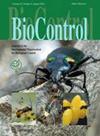经典生物防治方案的经济影响:在肯尼亚对背乳蝇的应用
IF 2.2
2区 农林科学
Q1 ENTOMOLOGY
引用次数: 0
摘要
摘要经典生物防治(CBC)是一种较安全的方法,通过进口、饲养和释放寄生蜂长尾蝇(Diachasmimorpha longicaudata)来抑制桔小实蝇(Bactrocera dorsalis)。虽然已通过非洲果蝇计划在肯尼亚释放了长尾蝇,但其扩散程度和随后的经济效益尚未确定。本文利用模糊元胞自动机方法对拟寄生虫的时空扩散进行了建模,并估计了投资于CBC方法的每一美元的净收益。我们根据2006年至2015年期间对该计划的投入,以及使用人工智能算法预测的寄生蜂扩散范围的结果,计算了投资回报。这项投资在16年期间产生了4280万美元的可观净现值。此外,成本效益比显示,每投入1美元,回报效益为93美元,证实了CBC计划的盈利能力。考虑到没有环境污染和CBC干预可能产生的不利影响,经济收益是显著的。研究结果支持了生态管理和区域管理绿僵杆菌的生物防治策略的投资。本文章由计算机程序翻译,如有差异,请以英文原文为准。
Economic impact of a classical biological control program: application to Diachasmimorpha longicaudata against Batrocera dorsalis fruit fly in Kenya
Abstract Classical biological control (CBC) has been exploited as a safer alternative for suppressing the oriental fruit fly, Bactrocera dorsalis, by importing, rearing, and releasing the larval parasitoid, Diachasmimorpha longicaudata . Although D. longicaudata has been released in Kenya through the Africa Fruit Fly Programme, the extent of its dispersal and subsequent economic benefits have not yet been established. This paper models the spatio-temporal dispersal of the parasitoid using the fuzzy cellular automata approaches and estimates the net benefit from each dollar invested in the CBC approach. We calculated the return on investment based on funding into the programme between 2006 and 2015 and the result of the dispersal range of the parasitoid predicted using an artificial intelligence algorithm. The investment yielded a significant net present value of US$42.8 million over the 16 years. Besides, the cost–benefit ratio showed that for every US$1 invested, the return benefit was US$93 , confirming the profitability of the CBC program. The economic gains are significant considering that there is no environmental contamination and possible adverse effects from the CBC intervention. The study findings support investment in biological control strategies for the eco-friendly and area-wide management of B. dorsalis.
求助全文
通过发布文献求助,成功后即可免费获取论文全文。
去求助
来源期刊

BioControl
生物-昆虫学
CiteScore
5.00
自引率
4.00%
发文量
42
审稿时长
12 months
期刊介绍:
BioControl, the official journal of the International Organization for Biological Control, presents original papers on basic and applied research in all aspects of biological control of invertebrate, vertebrate and weed pests, and plant diseases. Coverage includes biology and ecology of organisms for biological control, and aspects of use including biological controls for integrated pest management, such as plant resistance, pheromones and intercropping. Papers presenting only laboratory trials on non-target effects of pesticides on natural enemies are not considered but papers dealing with the corresponding effects on community dynamics of natural enemies are welcomed.
Organisms covered include parasitoids, invertebrate and vertebrate predators of pest animals and plants, mites, plant and insect pathogens, nematodes, and weeds.
The journal publishes interdisciplinary papers with a global perspective on the use of biological control in integrated pest management systems, and related developments in molecular biology and biotechnology that have direct relevance.
 求助内容:
求助内容: 应助结果提醒方式:
应助结果提醒方式:


